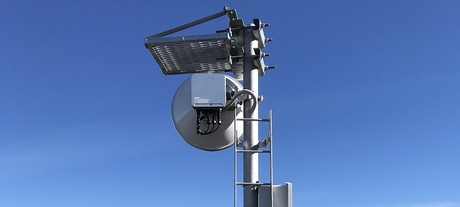NEC helps NSW Police stay connected

NEC’s iPasolink technology is providing long-distance links for the NSW Police’s state-wide microwave backhaul network.
NSW Police has awarded NEC Australia a contract to expand its state-wide microwave backhaul network, using NEC’s iPasolink VR platform.
NSW Police has the largest network out of all NSW public safety agencies, so it needs to have voice communication pretty much everywhere in the state.
“We started the relationship with NSW Police in 2014,” said NEC Australia’s Krisztian Som. “In the past they built their network using UHF radio, which is a pretty reliable way of backhauling base stations, but it’s got a very limited capacity. And also there was a re-farming of the UHF band, especially the 900 MHz band.”
In seeking alternatives to UHF, in 2014 NSW Police made the decision that when it next did an upgrade it would start to move away from that band. A tender was issued, which was awarded to NEC. The first phase of the rollout involved deploying about 180 iPasolink terminals covering regions centred on Grafton and Wagga Wagga.
Then, earlier this year, NSW Police issued another tender — awarded again to NEC Australia — for the New England/Hunter Valley region, involving 110 terminals, which are being deployed in some “very harsh and remote environments”, said Som.
Custom solution
NSW Police’s original UHF system needed only very light infrastructure, “so the challenge for them was to replace that old, ageing infrastructure with something new which gives them more capacity but is not going to overload the towers, because to upgrade the tower costs may be 10 times more than the radio itself”, said Som.
NSW Police also wanted to use a particular band (10.5 GHz) for the upgrade, which is Australia-specific and not fully aligned with the ETSI standard. There had been one company in the past, Mitec, which had a product that was suitable. “But since then no-one actually had a product because the market is too small to develop something specific,” said Som. “But we developed a specific configuration for the Police [and did] a lot of development to get them on board, and it paid off.”
“It needed R&D effort,” he added. “10.5 GHz is a standard band globally, but the channel spacing which is used in Australia is specific to Australia. So we needed to fine-tune the product and redesign the circuits inside.”
Technically, the project is considered a ‘maintenance program’ for NSW Police’s existing infrastructure and is being done in parallel with the rollout of the NSW Telco Authority’s separate Critical Communications Enhancement Program (CCEP) and Government Radio Network (GRN). “For us it’s good — we supply to both the CCEP for the GRN and also to the Police,” said Som.

Naturally, for such a mission-critical application, path redundancy is absolutely necessary. The network comprises unprotected links, but has been designed with ring topologies for overall protection for the sites. “They’re running an overlay MPLS network,” said Som. So in the case of a failed link, “normally the MPLS router will find an alternative way”.
“Each site has an east and west link coming in on the ring, and if the main path fails, then the MPLS router will just switch the traffic to the other way of the ring and get back to the same site,” he added.
Long distances
While there hasn’t been anything especially novel in the deployment, there are some noteworthy angles. “I think what’s interesting is they tried to achieve the longest distances they could with the equipment,” said Som. “All transmit power is really the highest on the market. What this allows for the Police is to deploy very, very long links with very small antennas.
“So for example, we’ve been deploying 50- to 60-kilometre links with 0.3- and 0.6-metre dishes — that’s quite phenomenal in the wireless space,” added Som. For the very longest hops, NSW Police uses mainly 7.5 GHz, which is not really prone to rain interference. “If you see the rain attenuation curve, it starts to go up at 10 GHz, so 10.5 GHz is still right at the edge,” said Som.
The capabilities of digital radio mean “we can go further than 10 years ago and we can increase the transmit power — there’s a lot better forward error correction now than there was 10 years ago”, added Som. “So that all helps to recover the signal, so we can go further with small antennas.”
Smaller antennas also equals smaller overall cost. Wherever NSW Police had existing tower infrastructure, it was used for mounting the iPasolink units without resorting to erecting expensive new towers. For 40- to 50-kilometre hops 10 years ago, “probably you would have been looking at a 1.8-metre dish which weighs 300 kg”, said Som. “You’d need a crane to put it up on the tower and you need a massive tower, as opposed to now having someone just grabbing a 30-centimetre antenna and climb the tower. So there has been a huge evolution in terms of technology.”
David Brogden, Commander Wireless Technology, NSW Police Force, added, “The new iPasolink platform is underpinning our critical radiocommunications network, essential to the protection of NSW’s seven million people. Not only is it robust in all conditions but its light weight also helps us reduce operational costs.”
Please follow us and share on Twitter and Facebook. You can also subscribe for FREE to our weekly newsletter and bimonthly magazine.
Why P25 technology remains a good fit for public safety communications
Digital LMR technology ensures police officers, firefighters and emergency management teams can...
From past to present: leveraging satellite data for better disaster resilience
Whether monitoring flood-prone regions or assessing wildfire-prone landscapes, historical...
Lancashire Police adds in-car video to full vehicle fleet
Motorola Solutions' M500 in-car video solution observes a vehicle's environment from...





